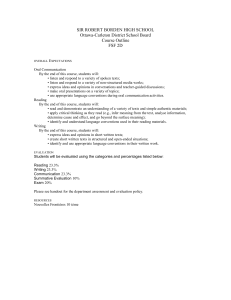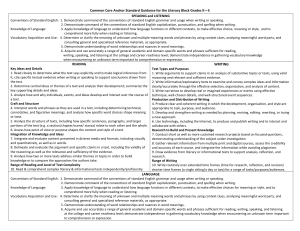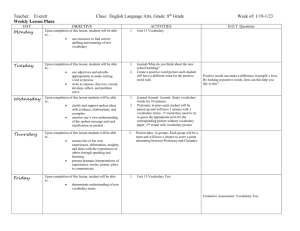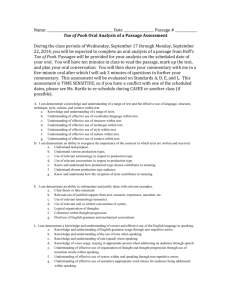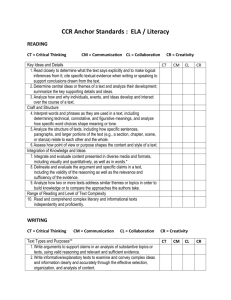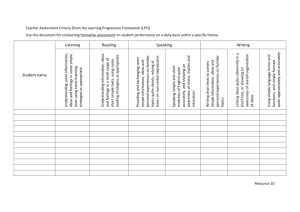Third Six Weeks Review
advertisement
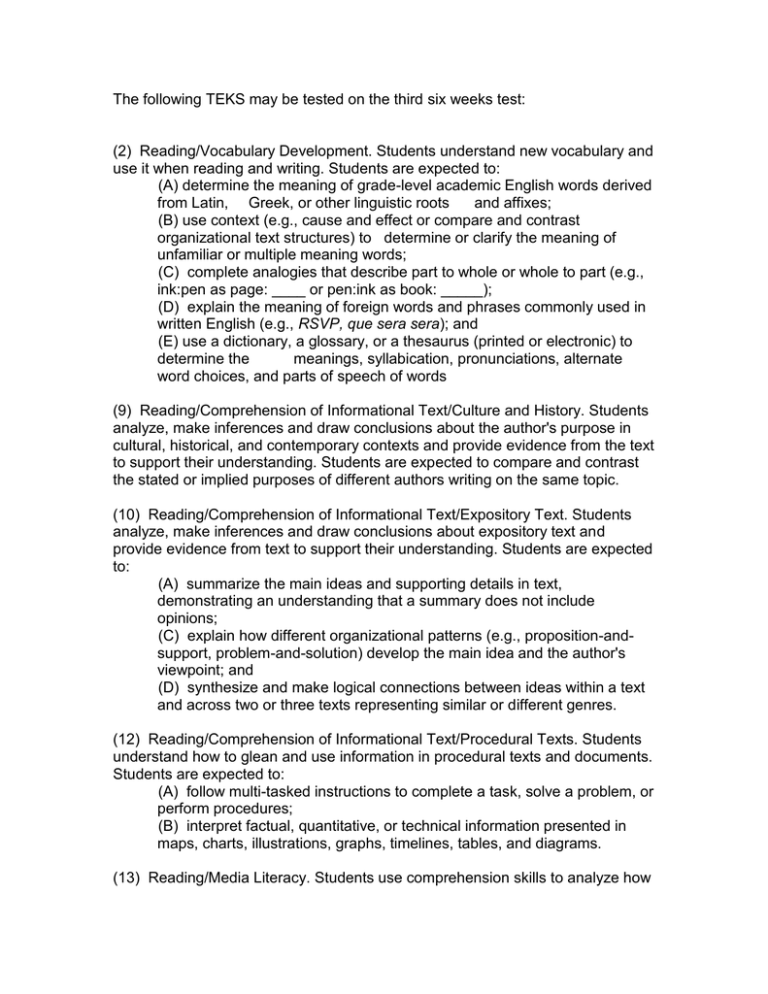
The following TEKS may be tested on the third six weeks test: (2) Reading/Vocabulary Development. Students understand new vocabulary and use it when reading and writing. Students are expected to: (A) determine the meaning of grade-level academic English words derived from Latin, Greek, or other linguistic roots and affixes; (B) use context (e.g., cause and effect or compare and contrast organizational text structures) to determine or clarify the meaning of unfamiliar or multiple meaning words; (C) complete analogies that describe part to whole or whole to part (e.g., ink:pen as page: ____ or pen:ink as book: _____); (D) explain the meaning of foreign words and phrases commonly used in written English (e.g., RSVP, que sera sera); and (E) use a dictionary, a glossary, or a thesaurus (printed or electronic) to determine the meanings, syllabication, pronunciations, alternate word choices, and parts of speech of words (9) Reading/Comprehension of Informational Text/Culture and History. Students analyze, make inferences and draw conclusions about the author's purpose in cultural, historical, and contemporary contexts and provide evidence from the text to support their understanding. Students are expected to compare and contrast the stated or implied purposes of different authors writing on the same topic. (10) Reading/Comprehension of Informational Text/Expository Text. Students analyze, make inferences and draw conclusions about expository text and provide evidence from text to support their understanding. Students are expected to: (A) summarize the main ideas and supporting details in text, demonstrating an understanding that a summary does not include opinions; (C) explain how different organizational patterns (e.g., proposition-andsupport, problem-and-solution) develop the main idea and the author's viewpoint; and (D) synthesize and make logical connections between ideas within a text and across two or three texts representing similar or different genres. (12) Reading/Comprehension of Informational Text/Procedural Texts. Students understand how to glean and use information in procedural texts and documents. Students are expected to: (A) follow multi-tasked instructions to complete a task, solve a problem, or perform procedures; (B) interpret factual, quantitative, or technical information presented in maps, charts, illustrations, graphs, timelines, tables, and diagrams. (13) Reading/Media Literacy. Students use comprehension skills to analyze how words, images, graphics, and sounds work together in various forms to impact meaning. Students will continue to apply earlier standards with greater depth in increasingly more complex texts. Students are expected to: (A) explain messages conveyed in various forms of media; (B) recognize how various techniques influence viewers' emotions; (14) Writing/Writing Process. Students use elements of the writing process (planning, drafting, revising, editing, and publishing) to compose text. Students are expected to: (A) plan a first draft by selecting a genre appropriate for conveying the intended meaning to an audience, determining appropriate topics through a range of strategies (e.g., discussion, background reading, personal interests, interviews), and developing a thesis or controlling idea; (B) develop drafts by choosing an appropriate organizational strategy (e.g., sequence of events, cause-effect, compare-contrast) and building on ideas to create a focused, organized, and coherent piece of writing; (C) revise drafts to clarify meaning, enhance style, include simple and compound sentences, and improve transitions by adding, deleting, combining, and rearranging sentences or larger units of text after rethinking how well questions of purpose, audience, and genre have been addressed; (D) edit drafts for grammar, mechanics, and spelling; and (17) Writing/Expository and Procedural Texts. Students write expository and procedural or work-related texts to communicate ideas and information to specific audiences for specific purposes. Students are expected to: (A) create multi-paragraph essays to convey information about a topic that: (i) present effective introductions and concluding paragraphs; (ii) guide and inform the reader's understanding of key ideas and evidence; (iii) include specific facts, details, and examples in an appropriately organized structure; and (iv) use a variety of sentence structures and transitions to link paragraphs; (B) write informal letters that convey ideas, include important information, demonstrate a sense of closure, and use appropriate conventions (e.g., date, salutation, closing); (C) write responses to literary or expository texts and provide evidence from the text to demonstrate understanding; and (19) Oral and Written Conventions/Conventions. Students understand the function of and use the conventions of academic language when speaking and writing. Students will continue to apply earlier standards with greater complexity. Students are expected to: (A) use and understand the function of the following parts of speech in the context of reading, writing, and speaking: (ii) non-count nouns (e.g., rice, paper); (iv) conjunctive adverbs (e.g., consequently, furthermore, indeed); (viii) transitional words and phrases that demonstrate an understanding of the function of the transition related to the organization of the writing (e.g., on the contrary, in addition to); (19) Oral and Written Conventions/Conventions. Students understand the function of and use the conventions of academic language when speaking and writing. Students will continue to apply earlier standards with greater complexity. Students are expected to: (B) differentiate between the active and passive voice and know how to use them both; and (20) Oral and Written Conventions/Handwriting, Capitalization, and Punctuation. Students write legibly and use appropriate capitalization and punctuation conventions in their compositions. Students are expected to: (B) recognize and use punctuation marks including: (iii) parentheses, brackets, and ellipses (to indicate omissions and interruptions or incomplete statements); and (21) Oral and Written Conventions/Spelling. Students spell correctly. Students are expected to: (B) use spelling patterns and rules and print and electronic resources to determine and check correct spellings; and (26) Listening and Speaking/Listening. Students will use comprehension skills to listen attentively to others in formal and informal settings. Students will continue to apply earlier standards with greater complexity. Students are expected to: (B) follow and give oral instructions that include multiple action steps; and (C) paraphrase the major ideas and supporting evidence in formal and informal presentations. (27) Listening and Speaking/Speaking. Students speak clearly and to the point, using the conventions of language. Students will continue to apply earlier standards with greater complexity. Students are expected to give an organized presentation with a specific point of view, employing eye contact, speaking rate, volume, enunciation, natural gestures, and conventions of language to communicate ideas effectively. (28) Listening and Speaking/Teamwork. Students work productively with others in teams. Students will continue to apply earlier standards with greater complexity. Students are expected to participate in student-led discussions by eliciting and considering suggestions from other group members and by identifying points of agreement and disagreement. Reading/Comprehension Skills. Students use a flexible range of metacognitive reading skills in both assigned and independent reading to understand an author’s message. Students will continue to apply earlier standards with greater depth in increasingly more complex texts as they become self-directed, critical readers. The student is expected to: (B) ask literal, interpretive, evaluative, and universal questions of text; (C) monitor and adjust comprehension (e.g., using background knowledge; creating sensory images; rereading a portion aloud; generating questions); (D) make inferences about text and use textual evidence to support understanding; (E) summarize, paraphrase, and synthesize texts in ways that maintain meaning and logical order within a text and across texts; and (F) make connections (e.g., thematic links, author analysis) between and across multiple texts of various genres, and provide textual evidence. Students specifically need to know: Author’s purpose Latin root of ped Contrasting to given words from story Why authors present information as they do Inferring Outline Cause/effect Summary Compound sentence Analogies Chronological order Connecting passages Using a dictionary

